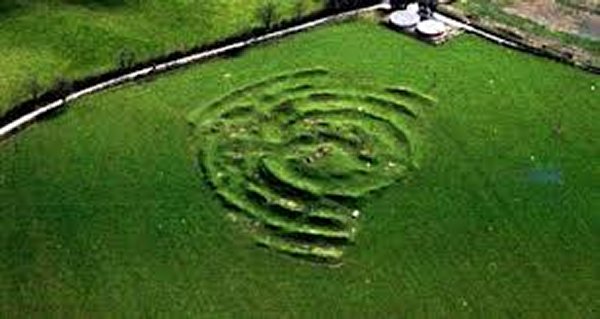MessageToEagle.com – Could the Hill of Ward be the place where the first Halloween bonfire was lit? Thousands of years ago, Druids used to set light to a huge bonfire here.
Now archaeologists digging at Tlachtga – the Hill of Ward, Ireland have found evidence of intense burning at the site dating back to 500 AD. This raises the intriguing question if this was where the beginning of the ancient Celtic holiday of Samhain, modern Halloween.
In the 17th Century, historian Geoffrey Keating wrote of the feast of Samhain, the pre-Christian forerunner of Halloween, and the fierce fire on a hill in Meath.

According to a report published by BBC “it was originally the Celtic feast of Samhain – a pre-Christian festival that began at sunset on 31 October and ran until sunset on 1 November,
For the druids and, later, the priests of ancient Ireland it was an important ritual as the world turned dark and winter took sway.
It was meant to be the night when the veil between this world and the other world was at its thinnest and the dead were very near – especially on the hill of Tlachtga.
It became what modern Christians call All Souls Day – a ceremony to remember all those who died.
It also marked the end of the harvest – a celebration of summer’s bounty before digging in for the long winter ahead.
The celebration of the harvest is enshrined in the modern day Halloween in Ireland.
Apples play a central role in parties. A basin is filled with water and apples are put into it.
People have to dunk for the apples by plunging their faces into the basin and removing them with their mouths – no hands allowed.
Apples are also hung from the ceiling on strings and, again, without using your hands, you jump and try to take a bite.
Part of the traditional Halloween feast is the apple cake. Coins are hidden inside as a surprise.
A fruit bread called brack is also served and at Halloween, the tradition is to hide a brass ring inside – whoever gets the ring in their slice, will be married soon.
Irish writer James Joyce wrote about Halloween in his short story, Clay, in the Dubliners collection.
In it, there is a party that features another traditional Irish Halloween game.
A volunteer is blindfolded and asked to choose from three saucers – one has a prayer book and symbolises a calling to the religious life; one has a ring to signify marriage and the third holds clay, signifying death.
Archaeologist Dr Steve Davis, University College Dublin, was one of a team who spent the summer of 2014 working at Tlachtga, about 12 miles from the Hill of Tara.
“There are very few monuments in Ireland that we consider comparable to this,” he said.
“This is a massive ceremonial enclosure. The location of it is striking with nearly 360 degree views around it, right in the heart of a major monumental landscape.”
Dr Davis said this was a place to which people had been coming for thousands of years.
“Geoffrey Keating who wrote the History of Ireland, talks about this in the 17th Century. He said the druids lit a fire and had celebrations,” he said.
Tradition has it that on Samhain Eve – celebrated on 31 October, Halloween – all fires were extinguished across Ireland.
A huge bonfire was lit on Tlachtga and all the people had to come and light their fires from this central fire.
See also:
Mystery Of The Black Irish People: Who Were They?
Mystery Of The Banshee – Is The Celtic Death Messenger Linked To The Tuatha De’Dannan Race?
10 Ancient Celtic Symbols Explained
Brian Boru – Famous And Brave Irish Hero Who Dared To Chase Off The Vikings
Tlachtga is the name of an ancient druidess.
“It is a magical and mystical place,” said Dr Davis.
“We have found evidence of intense burning there, whether you want to equate that with Samhain or not.
“This monument is associated with fire. The medieval texts would associate this very strongly with an annual fire festival,” he said.
“It may also have been a place for crafting metal and glass and in those times, very few people knew how to do that, so it too would have been magical.”
Significantly, archaeologists also found the skeleton of a small child who was less than a year old – a similar skeleton was found at Rath na Rí on the nearby hill of Tara, once the seat of the ancient high kings of Ireland.
“There has been a suggestion that one of the reasons the site is not better known is that it was written out of the Patrick story – that it was so infamous that the church did a very good job of trying to erase it from the mythology,” Dr Davis said.
This year, hundreds of people are returning to Tlachtga to celebrate Samhain with a fire festival and a torch lit procession.
The Spirits of Meath Halloween festival has become a popular attraction and the old ceremony on Tlachtga has been revived.
Next year, the archaeologists hope to return to the site. Their work has been funded by the Royal Irish Academy, Meath County Council and the Office of Public Works.
There are still secrets to be unearthed here – ancient Irish secrets that have lain buried for hundreds and thousands of years.
MessageToEagle.com






